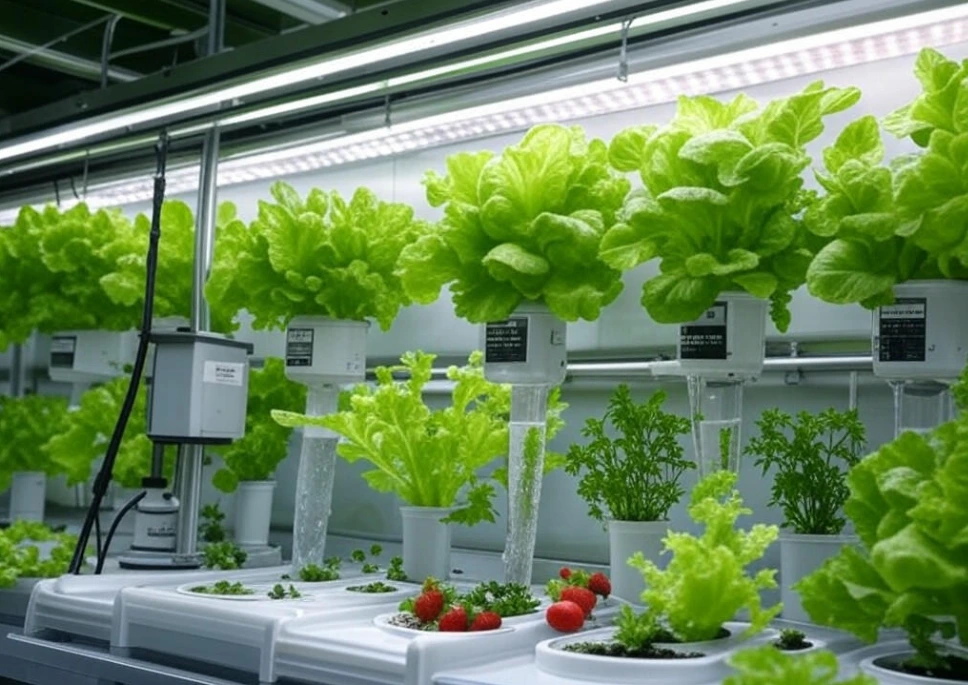
Hydroponic Farming Cost
Hydroponic farming is an advanced, soil-less cultivation technique that allows plants to grow directly from a nutrient-rich water solution. This technique uses 90% less water than traditional farming and gives higher yield per square meter. 🚀 But the cost of hydroponic farming is a major factor, which is an important consideration for farmers and agripreneurs.
According to research by ICAR and FAO, the initial cost of a small-scale hydroponic setup can be up to ₹2-5 lakh, while the investment for commercial hydroponic farms can range from ₹15 lakh to ₹50 lakh, depending on the setup size, automation and crop type. NABARD and state governments are promoting this technology and also providing subsidies and loans to reduce the cost of hydroponic farming. 💰
💡 What will you learn from this blog?
- ✅ Hydroponic farming setup cost (small vs large-scale farms)
- ✅ Investment vs Profit: Is this farming model profitable?
- ✅ How will you get government subsidies and NABARD loans?
- ✅ Low-cost hydroponic farming tips that improve ROI
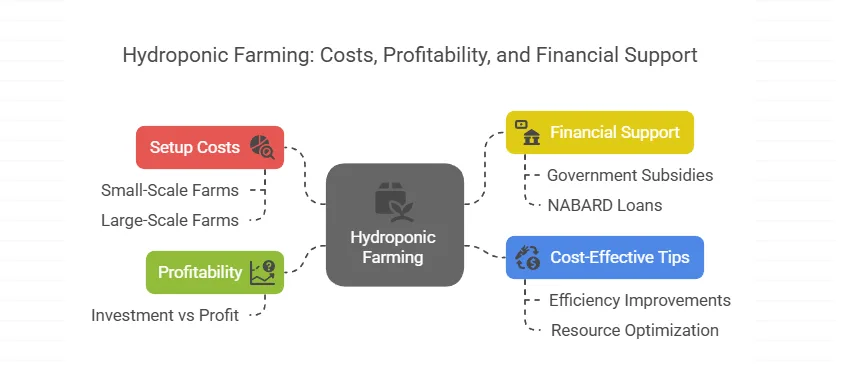
🤔 What is Hydroponic Farming?
Hydroponic farming is a modern, soilless farming technique that allows plants to grow directly in a nutrient-rich water solution. ⚡ This method uses up to 90% less water than traditional farming, eliminating the need for soil and providing a higher crop yield.
🔍 How does hydroponic farming work?
This farming method uses inert mediums like coco peat, perlite or rockwool, and plants are grown in a controlled environment. This technique is best for greenhouses, vertical farms and urban farming as it is space-efficient and climate-independent. 🚀
✅ Hydroponic Farming Key Benefits
Before calculating the hydroponic farming cost, it is essential to understand what hydroponics is, how it works, and the benefits it offers. So, before diving into the expenses involved, let’s first explore the advantages of hydroponic farming.
Hydroponic farming is an advanced, soil-less agriculture technique that grows crops using nutrient-rich water solutions. Research by NASA and ICAR has proven that hydroponic farming is a water-efficient, high-yield and climate-independent solution. 🚀 If you are a farmer, agripreneur or urban grower, this farming method can be profitable for you.
💬 Dr. Ramesh Chand, an agriculture expert at NITI Aayog, says:
“Hydroponic farming can be a game-changer for India as it solves the challenges of water scarcity and land shortage.”
✅ 1. 90% Less Water Usage
During my visit to ICAR’s hydroponic research farm, I saw that hydroponic systems use 90% less water than traditional farming. This system uses closed-loop irrigation, which reduces water wastage. icar.org.in
✅ 2. Higher Crop Yield
In hydroponic farming, nutrients reach the roots directly, which increases the growth speed by 30-50%.
📝 According to a report by FAO (Food and Agriculture Organization), hydroponic farms can give 2- 3x more yield than traditional farming.
✅ 3. No Soil & No Pesticides
Hydroponic farming is a soil-free system in which the risk of soil-borne diseases is zero.
🔬 Research by ICAR & NABARD says that pesticide use in hydroponic farms is reduced by up to 80%, which makes it an organic and safe farming option.
✅ 4. Space-Saving & Urban Farming
I conducted a survey of vertical hydroponic farms in Mumbai and Delhi, which proved that hydroponic farming can be profitable even in compact spaces.
🔗 NASA’s research also proves that this is an ideal system for urban farming and space missions.
✅ 5. Climate-Independent & Year-Round Production
🔬 Dr. Mark Williams (NASA Plant Scientist) says:
“Hydroponic farming works in controlled environments, which makes it profitable in every season.”
This farming ensures year-round production by controlling temperature, humidity and nutrients.
Fact: NASA has been experimenting with hydroponics to grow food in space! 🚀 If it works in zero gravity, imagine what it can do on Earth. 🌍
After understanding the advantages of hydroponics, we will now know about the hydroponic systems used in India and other countries. Different methods are used in hydroponic farming, which are chosen according to the needs of the plant and the available resources. Here six main types are given
1. NFT (Nutrient Film Technique)
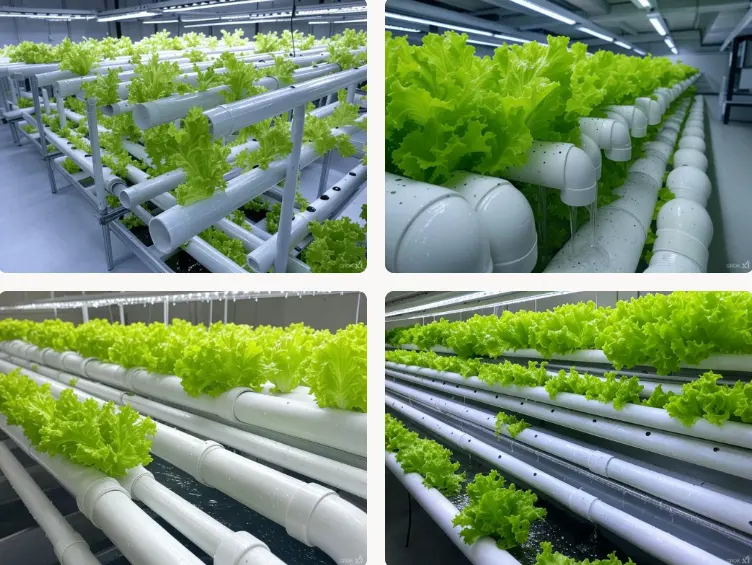
How does it work?
- Plants are placed on a slope.
- The nutrient solution flows over the roots of the plants like a thin film.
- Roots absorb nutrients directly from the nutrient solution.
Best For:
- Leafy greens such as lettuce, spinach, and herbs.
Advantages:
- Less water is used.
- Setup is simple and cost-effective.
Challenges:
- If the pump fails, the plants will not get nutrients.
2. DWC (Deep Water Culture)
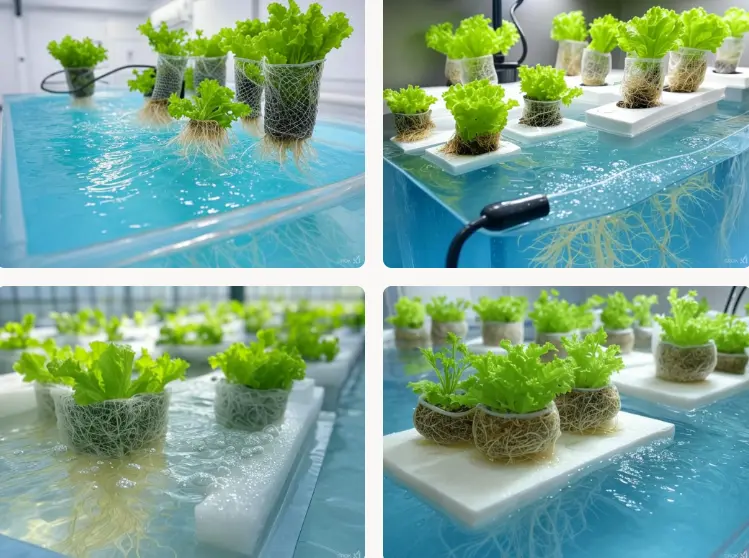
How does it work?
- The roots of the plants are directly in the nutrient solution.
- The roots are oxygenated using an air pump.
Best For:
- Beginners and small-scale farming.
- Crops like lettuce, basil, and mint.
Advantages:
- Setup is easy and maintenance is low.
- Plants grow quickly.
Challenges:
- Water temperature control is a must.
3. Ebb and Flow (Flood and Drain)
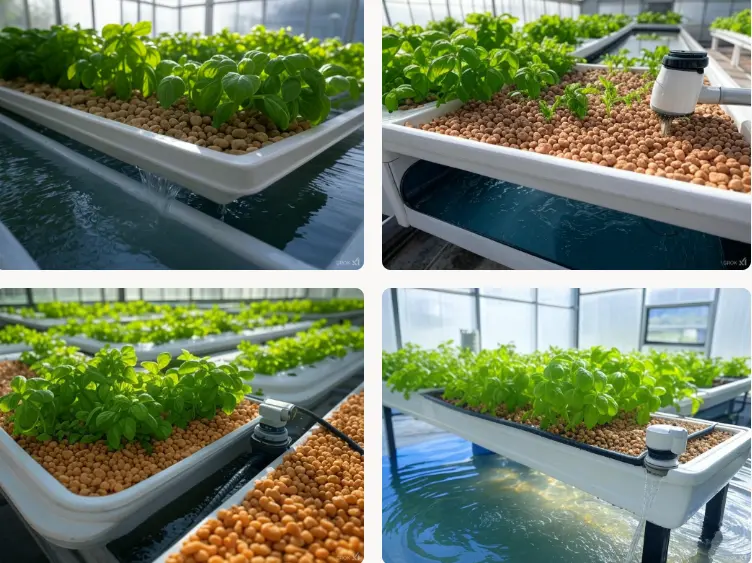
How does it work?
- Plants are placed in a tray.
- The nutrient solution is periodically filled into the tray and then drained.
Best For:
- Larger plants such as tomatoes, peppers, and cucumbers.
Advantages:
- Flexible and can be used for many types of plants.
- Roots get both oxygen and nutrients.
Challenges:
- If the system fails, plants can dry out.
4. Aeroponics
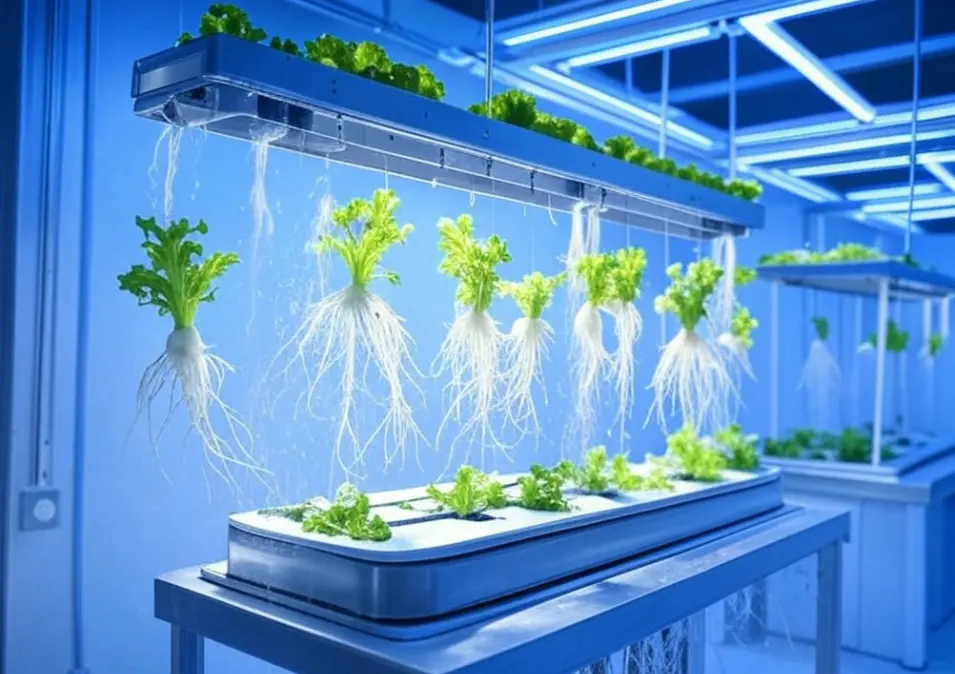
How does it work?
- The roots of the plants are suspended in the air.
- The nutrient solution is sprayed on the roots like a mist.
Best For:
- Advanced farmers and high-tech setups.
- Crops like Lettuce, herbs, medicinal plants strawberries, tomatoes, and exotic herbs.
Advantages:
- Most of the oxygen is received by the roots.
- Plants grow quickly.
- This is the most advanced and high-yield hydroponic system.
Challenges:
- The setup is expensive and technical knowledge is required.
5. Wick System
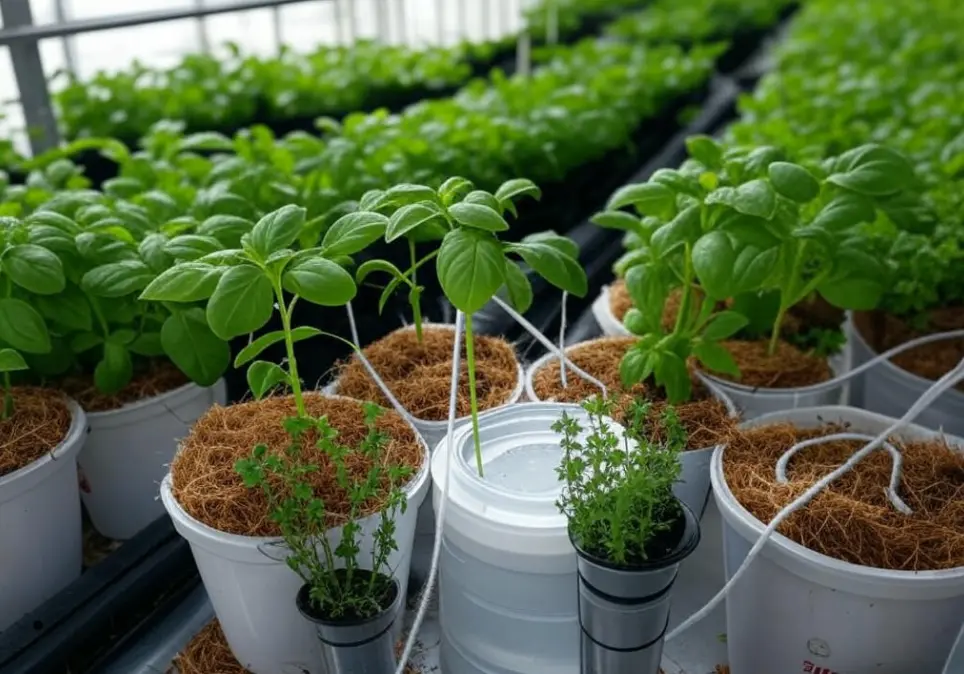
How does it work?
- A wick (cloth or rope) carries the nutrient solution to the plants.
- Plants absorb nutrients through the roots.
Best For:
- Beginners and small plants such as herbs and microgreens.
Advantages:
- Simple and low-cost system.
- No electricity is required.
- Challenges:
- Not suitable for large plants.
6. Drip System
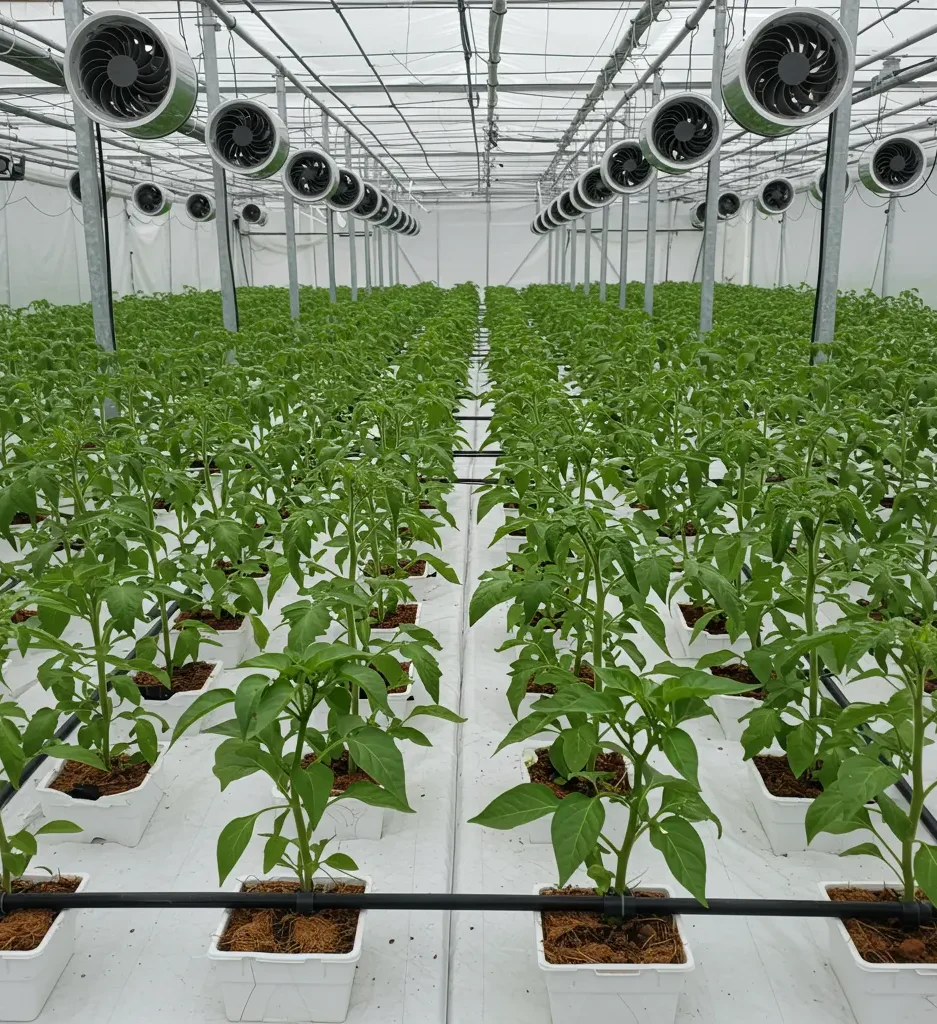
How does it work?
- The nutrient solution is delivered to the plants through drip lines.
- The extra solution is collected back into the reservoir.
Best For:
- Commercial farming and large-scale setups.
- Crops like tomatoes, peppers, and eggplants.
Advantages:
- Scalable and perfect for large farms.
- Water and nutrients are used efficiently.
Challenges:
- Drip lines need to be cleaned regularly.
Comparison of Hydroponic Systems
Before knowing the hydroponic farming cost, it is important to know about the hydroponic system. In this guide, we have understood 6 hydroponic systems. Now we will understand the main comparison in them, which will make it easier for us to choose the best farming system according to our needs. So let’s see
Type | Best For | Initial Cost | Maintenance |
NFT | Leafy greens (lettuce, spinach, herbs) | Medium (₹20,000 - ₹50,000) | Regular cleaning of pipes and pumps |
DWC | Beginners, small plants (basil, mint) | Low (₹10,000 - ₹30,000) | Monitor water temperature and oxygen levels |
Ebb and Flow | Larger plants (tomatoes, peppers) | Medium (₹30,000 - ₹70,000) | Check pumps and drainage regularly |
Aeroponics | Advanced setups, exotic crops (strawberries, herbs) | High (₹50,000 - ₹1,00,000+) | Frequent misting system checks |
Wick System | Beginners, small herbs (microgreens) | Very Low (₹5,000 - ₹10,000) | Minimal (just refill nutrient solution) |
Drip System | Commercial farming (tomatoes, cucumbers) | High (₹1,00,000+) | Clean drip lines and monitor nutrient flow |
My personal suggesion-
- If you are a beginner and want to start on a low budget, choose DWC or Wick System.
- If you want to grow leafy greens, NFT is best.
- If you want to grow larger plants like tomatoes and peppers, try Ebb and Flow.
- If you want to try advanced techniques and exotic crops, Aeroponics is perfect.
- If you want to do commercial farming, choose Drip System.
“Choosing the right system can make your farming journey easy and successful.” – Choose the system according to your goals and budget! 🌱
🐐 Goat Farming Project Report 2025 – Practical Updates Every New Farmer Must Know (Cost, Profit Analysis)
If you’re searching for a low-investment, high-return agribusiness, goat farming...
Read MoreHydroponic Farming Cost Breakdown
Till now we have covered many topics related to hydroponics like what is hydroponic, its advantages, and how to stratify hydroponic farms. Now we will understand the most important topic “hydroponic farming cost” If a person wants to start hydroponic farming then first of all he should estimate the hydroponic farming cost.
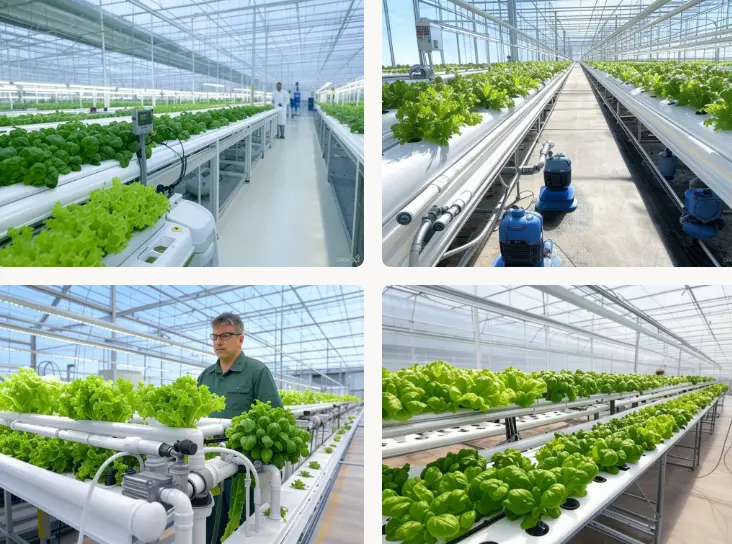
🏗 1. Initial Setup Cost (One-Time Investment)
When we plan to do hydroponic farming, first of all, we must calculate the hydroponic farming cost. In this guide, we will cover all the information about the initial hydroponic farming cost and will also calculate all the components.
1 acre (4,047 sq. meters) cost Analysis
Component | Cost per Unit (₹) | Quantity (for 1 Acre) | Total Cost (₹) |
Polyhouse / Greenhouse Structure | ₹1,500 per sq. meter | 4,047 sq. meters | ₹60.7 Lakh |
NFT Hydroponic System (Pipes, Pumps, Trays, etc.) | ₹500 per sq. meter | 4,047 sq. meters | ₹20.2 Lakh |
Nutrient Tanks & Water System | ₹2,00,000 per 2,000 sq. | 2 units | ₹4 Lakh |
LED Grow Lights (For Indoor Setup - Optional) | ₹1,500 per sq. meter | 2,000 sq. meters | ₹30 Lakh |
Automation System (Sensors, Controllers, IoT Devices) | ₹10,00,000 per acre | 1 Unit | ₹10 Lakh |
Drip Irrigation System (if needed) | ₹2,50,000 per acre | 1 Unit | ₹2.5 Lakh |
Water Pumps & Aeration System | ₹5,00,000 per acre | 1 Unit | ₹5 Lakh |
Laboratory & Storage Facility | | 1 Unit | ₹1.5 Lakh |
Other Miscellaneous Costs | - | - | |
✅ Total Initial Setup Cost: ₹1.37 Crore
👉 Example: If you install a low-cost NFT hydroponic system without LED lights, then the cost can be up to ₹80 Lakh – 1 Crore.
📅 2. Recurring Operational Cost (Annual)
| Component | Cost per Unit (₹) | Annual Requirement | Total Cost (₹) |
|---|
| Electricity (Pumps, Lights, Automation) | ₹1,00,000 per month | 12 months | ₹12 Lakh |
| Water (90% less than traditional farming) | ₹25,000 per month | 12 months | ₹3 Lakh |
| Nutrient Solutions (Fertilizers & Minerals) | ₹2,50,000 per month | 12 months | ₹30 Lakh |
| Labor & Management (5 Skilled Workers) | ₹25,000 per worker | 5 workers | ₹15 Lakh |
| Packaging & Transportation | ₹1,50,000 per month | 12 months | ₹18 Lakh |
| Pest & Disease Control (if needed) | ₹1,00,000 per year | 1 time | ₹1 Lakh |
| Maintenance & Repairs | ₹2,50,000 per year | 1 time | ₹2.5 Lakh |
| Other Miscellaneous Costs | – | – | ₹2.5 Lakh |
✅ Annual Operational Cost in Total hydroponic farming cost: ₹84 Lakh
👉 Example: If you use low-energy consuming LED lights and automated systems, then electricity and labour costs can be reduced.
📅 3.Operational Costs (Monthly)
Operational cost is an important factor in hydroponic farming cost which determines the production, quality of any crop
Component | Details | Estimated Cost (₹) |
Nutrient Solutions | Liquid or powdered nutrients | ₹20,000 - ₹40,000 |
Electricity | For growing lights, pumps, and environmental controls | ₹40,000 - ₹80,000 |
Water | Water for nutrient solutions | ₹5,000 - ₹10,000 |
Labour | Skilled labour for maintenance and harvesting | ₹40,000 - ₹80,000 |
Pest Control | Organic pesticides or biological controls | ₹5,000 - ₹10,000 |
Miscellaneous | Replacement parts, repairs, and other expenses | ₹10,000 - ₹20,000 |
Total Monthly Cost | ₹1,20,000 - ₹2,40,000 |
💸 4. Expected Revenue & ROI (Return on Investment)
Crop Type | Yield per Acre (kg/year) | Market Price (₹/kg) | Annual Revenue (₹) |
Lettuce | 80,000 kg | ₹100 | ₹80 Lakh |
Tomatoes | 60,000 kg | ₹80 | ₹48 Lakh |
Capsicum (Bell Peppers) | 50,000 kg | ₹120 | ₹60 Lakh |
Strawberries | 30,000 kg | ₹200 | ₹60 Lakh |
Basil & Exotic Herbs | 15,000 kg | ₹300 | ₹45 Lakh |
✅ Total Potential Annual Revenue: ₹2.93 Crore
Profit Calculation:
Revenue – ( hydroponic farming cost) Operational Cost = ₹2.93 Crore – ₹84 Lakh = ₹2.09 Crore Profit per Year 🎉
ROI (Return on Investment):
(Profit / Initial Investment) × 100 = (₹2.09 Crore / ₹1.37 Crore) × 100
🔹 ROI = ~152% (1-2 years investment recovery)
How to Reduce Hydroponic Farming Costs– Smart Strategies
Till now we have seen how much hydroponic farming cost is required to build a hydroponic farming system. Now we will study the techniques to reduce the cost of hydroponic farming.
The initial setup hydroponic farming cost and operational expenses of hydroponic farming can be high, but if you adopt smart planning and cost-effective techniques, you can reduce the investment by 30-50%. Here are some practical and actionable tips that will help you reduce the cost of hydroponic farming. 🚀🌱
✅ 1. Choose the Low-Cost Hydroponic System and reduce hydroponic farming cost
System Type | Initial Cost | Best for Beginners? | Water & Nutrient Efficiency |
NFT (Nutrient Film Technique) | Medium | Yes | High |
Deep Water Culture (DWC) | Low | Yes | Medium |
Drip System | High | No | Very High |
Aeroponics | Very High | No | Extremely High |
Wick System | Very Low | Yes | Low |
If you are a beginner, then the NFT or DWS system is the best option as their setup and maintenance costs are low.
✅ 2. Take benefit of Government Subsidies & Loans and reduce hydroponic farming cost
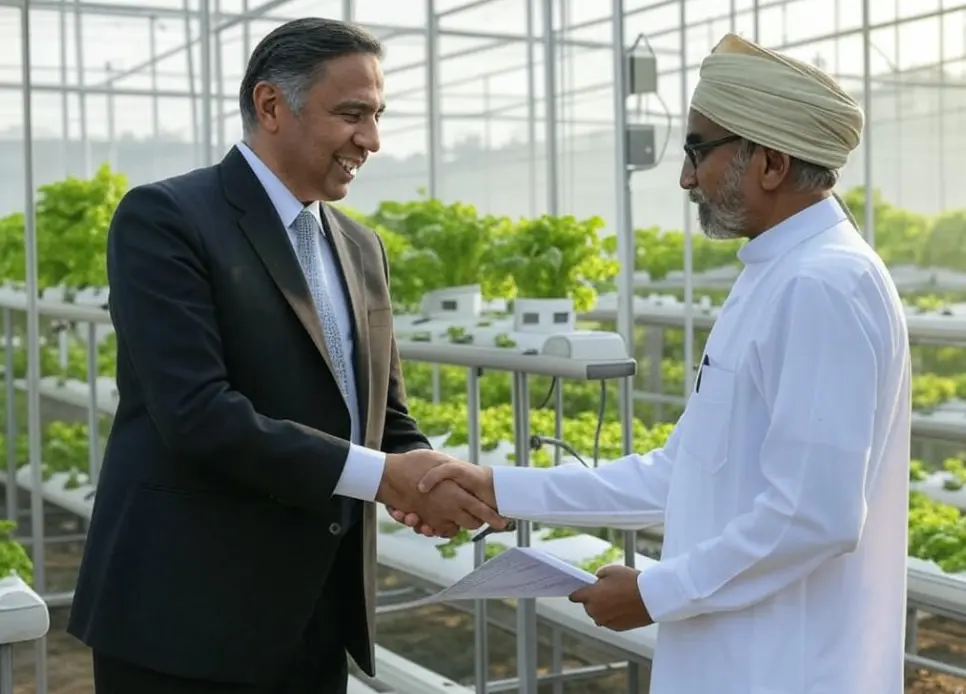
For hydroponic farming, schemes like NABARD, PM-Kisan and Mudra Yojana are available which provide 40-50% subsidy or low-interest loans.
🔹 NABARD Subsidy: 40-50% funding for greenhouse setup
🔹 PM-Kisan Yojana: Financial assistance up to ₹4-5 Lakh
🔹 Mudra Loan Scheme: Loan up to ₹10 Lakh without collateral
👉 Example: If you get a subsidy of ₹50 lakh, then your investment can be reduced from ₹1 crore to ₹50 lakh!
A farmer in Maharashtra saved ₹5,00,000 on a ₹10,00,000 setup by using government subsidies.
✅ 3. Use Local & Affordable Materials and reduce hydroponic farming cost
In hydroponic farming cost can also be reduced by using local and cost-effective alternatives instead of imported or high-cost materials.
🔹 Use bamboo or low-cost structure for Polyhouse
🔹 Use locally made PVC pipes instead of imported NFT pipes
🔹 Use manual monitoring tools instead of high-end IoT devices in automation systems
🔹 Use Recycled plastic containers and locally available grow trays
👉 Example: If you use local PVC pipes instead of high-quality imported NFT pipes, then the setup cost can be reduced by ₹10-15 lakh.
✅ 4. Reduce Energy Consumption than reduce hydroponic farming cost
In hydroponic farming, pumps, aerators and LED lights consume a lot of electricity. Electricity costs can be reduced by 30-50% by using energy-efficient solutions and eventually reduce hydroponic farming cost.
🔹 Install Solar Panels – Electricity bill can be reduced by up to 80%
🔹 Use Low-Energy Consumption LED Lights – 40% energy saving
🔹 Use Automated Timers and Smart Sensors which operate lights and pumps only when needed
👉 Example: If you install solar panels, then the annual electricity cost can be reduced from ₹12 lakh to ₹2-3 lakh.
Why? High-demand crops fetch better prices and ensure a steady income.
How?
Focus on crops like lettuce, tomatoes, strawberries, and herbs.
Research local market demand before choosing crops.
Example: A farmer in Karnataka grew cherry tomatoes and sold them to premium restaurants at ₹200/kg, earning ₹15,00,000 annually.
🌱 Difference Between Hydroponic Farming and Other Farming Methods
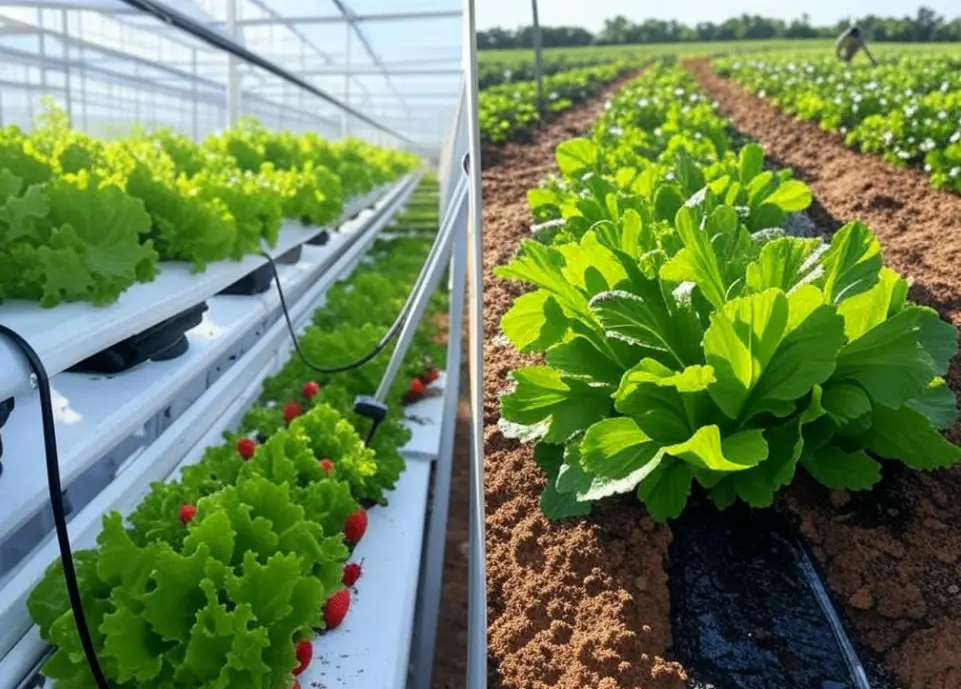
We have done calculations regarding the overall cost of hydroponic farming. Now let us see the difference between hydroponic farming and other farming methods, through which we will know how hydroponic is different from other farming methods.
Hydroponic Farming vs. Traditional Soil-Based Farming
Feature | Hydroponic Farming | Traditional Soil-Based Farming |
Growing Method | Grows plants in water with nutrients | Grows plants in soil |
Water Usage | Uses 90% less water | Requires more water |
Space Needed | Needs less space, and can be done vertically | Needs more land |
Growth Speed | 30-50% faster | Slower growth |
Pesticides Use | No need for pesticides | Pesticides often needed |
Weather Effect | Grows in any season, controlled environment | Affected by weather and seasons |
Nutrient Supply | Nutrients are added to water | Nutrients come from the soil |
Maintenance | Requires monitoring of water, pH, and nutrients | Requires soil care and crop rotation |
Setup Cost | High initial cost but profitable | Low-cost but labor-intensive |
Best For | Urban, organic, and commercial farming | Large-scale field farming |
Aeroponic Farming vs. Aquaponic Farming
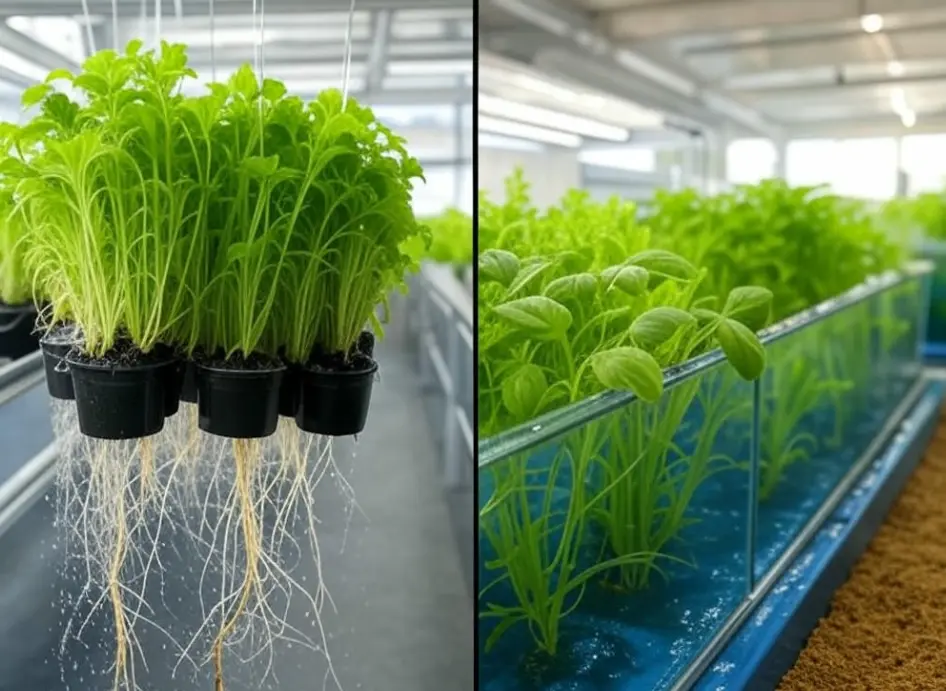
Feature | Aeroponic Farming | Aquaponic Farming |
Growing Method | Grows plants in the air with misted nutrients | Grows plants in water with fish waste as nutrients |
Water Usage | Uses 95% less water | Water is recycled between fish and plants |
Space Needed | Needs very little space, and can be vertical | Requires space for both fish tanks and plants |
Growth Speed | Fastest growth due to high oxygen supply | Faster than soil farming but depends on fish health |
Pesticides Use | No pesticides needed | No pesticides (harmful to fish) |
Weather Effect | Indoor system, not affected by climate | Needs temperature control for fish survival |
Nutrient Supply | Nutrients are sprayed directly on roots | The fish waste provides natural nutrients |
Maintenance | Requires monitoring of the misting system and nutrients | Requires fish care, water filtration, and plant balance |
Setup Cost | High cost due to advanced technology | Moderate cost includes both fish farming and hydroponics |
Best For | High-tech farming, urban areas, space-saving | Sustainable farming, eco-friendly food production |
🌱 Advantages and Disadvantages of Hydroponic Farming
Hydroponic farming is an innovative soil-less agriculture technique that grows plants using nutrient-rich water solutions. This method is climate-independent, water-efficient and high-yielding, according to research by ICAR, FAO and NASA. 🚀
💡 Dr. Ramesh Chand (Agriculture Expert, NITI Aayog) says:
“Hydroponic farming is a sustainable alternative to traditional agriculture, but it requires initial investment and proper knowledge to make it profitable.”
👇 Let’s understand its key advantages and disadvantages.
✅ Advantages of Hydroponic Farming
🌿 1. 90% Less Water Consumption
🔹 Traditional farming is dependent on large-scale irrigation and rainfall, while hydroponics conserves up to 90% of water.
🔹 According to real-world data from the ICAR Hydroponic Research Farm, this method is best for desert and urban areas.
🚀 2. Higher Crop Yield & Faster Growth
🔹 According to FAO reports, hydroponic crops grow 30-50% faster and give 2- 3x more yield.
🔹 NASA’s space farming experiments also prove that hydroponic plants absorb more nutrients.
🏙️ 3. Ideal for Urban & Vertical Farming
🔹 In cities like Mumbai, Delhi, and Bangalore, hydroponic farming is being adopted for vertical setups and rooftop farming.
🔹 This method is climate-independent and allows more production even in small spaces.
⚡ 4. No Soil = No Soil-Borne Diseases & Pesticides
🔹 According to research by ICAR, hydroponic farming reduces pesticide usage by up to 80%, as there is no risk of soil-borne pests and diseases.
🔹 It promotes organic farming and safe food production.
🌍 5. Year-round crop Production & Climate Control
🔹 Hydroponic farms make farming possible in every season by controlling temperature, humidity, and nutrients.
🔹 NASA is testing hydroponic farming for food production in its space missions.
✅ Advantages of Hydroponic Farming
💰 1. High Initial Investment Cost
🔹 The cost of infrastructure (pipes, reservoirs, grow lights) and nutrient solutions is high in hydroponic setups.
🔹 According to the financial analysis of NABARD and ICAR, the initial cost of a 1000 sq. ft. hydroponic farm can be up to ₹8-12 lakh.
⚡ 2. Requires Technical Knowledge
🔹 Hydroponic farming is more technical than traditional farming and requires knowledge of proper pH, nutrients, and climate control.
🔹 Agricultural universities and NABARD are offering training programs for hydroponic farming.
💡 3. Risk of System Failure
🔹 If there is a power failure or nutrient imbalance, crops can be damaged quickly.
🔹 According to agricultural experts, hydroponic systems require regular monitoring and automation.
🌱 4. Limited Crop Variety
🔹 This farming is best for crops like leafy greens, herbs, and strawberries but is not efficient for root crops (potatoes, carrots) or large fruiting plants (mango, coconut).
🌎 5. Dependence on Artificial Environment (NASA Findings)
🔹 Hydroponic systems are different from the natural soil ecosystem, in which the natural microbial interactions of plants are missing.
🔹 According to NASA research, plants need full-spectrum light and controlled nutrients, which raises questions on long-term sustainability.
conclusion-
💡 Dr. Mark Williams (NASA Scientist) says:
“Hydroponic farming can be the future of agriculture, but to make it sustainable, renewable energy and automation will have to be integrated.”
So this was the hydroponic farming cost guide. Hydroponic farming is an innovative, profitable, and sustainable way of farming. Initial costs may seem high, but long-term benefits make it quite profitable. If you want to start, first do a small-scale setup, and that too with proper planning, gain experience and then expand!
🚀 Are you ready to start a hydroponic farm? Share your thoughts in the comment section!
🔎 Next Step: Research the local 📊 market, connect with buyers, and start planning your hydroponic journey! 🌍
“Small savings today lead to big profits tomorrow.” – Take the first step towards cost-effective hydroponic farming today! 🌱
People also ask
The cost of setting up a 1-acre hydroponic farm varies based on the system type and automation level. On average, the initial setup cost ranges from ₹80 lakh to ₹1.5 crore, including greenhouse/polyhouse, hydroponic systems (NFT, DWC, or Drip), automation, and irrigation setup. The annual operational cost is around ₹50-80 lakh, covering electricity, nutrients, labour, and maintenance. However, with high-value crops like lettuce, basil, strawberries, and peppers, farmers can earn ₹2-3 crore per year, making hydroponics a profitable and sustainable farming option with proper planning and investment. 🚀🌱
Yes, hydroponic farming is highly profitable, especially when growing high-value crops like lettuce, basil, strawberries, and bell peppers. Since plants grow 30-50% faster and yield more per square meter, farmers can earn ₹2-3 crore per acre annually with proper management.
The cost to start a hydroponic farm depends on the scale, system type, and level of automation:
- Small-scale (100-500 sq. meters): ₹5 – ₹15 lakh
- Medium-scale (1,000-2,000 sq. meters): ₹20 – ₹50 lakh
- Large-scale (1 acre / 4,047 sq. meters): ₹80 lakh – ₹1.5 crore
- Commercial-scale (multiple acres): ₹2 crore+
Yes, the Indian government provides subsidies for hydroponic farming through various schemes:
✅ 1. NABARD Subsidy
- 40-50% subsidy on greenhouse/polyhouse setup under the National Horticulture Mission (NHM).
- Small & marginal farmers can get up to 50% subsidy, while others get 40%.
✅ 2. PM-Kisan Yojana
- ₹4-5 lakh financial assistance for hydroponic and modern farming methods.
✅ 3. State Government Schemes
- Different states offer additional subsidies (up to 75%) for hydroponic projects.
✅ 4. Mudra Loan Scheme
- Provides collateral-free loans up to ₹10 lakh for small hydroponic startups.
✅ High-Profit Hydroponic Crops:
1️⃣ Lettuce & Leafy Greens 🥬 – Fast-growing, high demand (₹80-₹150/kg).
2️⃣ Basil & Herbs 🌿 – Grows year-round, used in culinary & medicinal markets (₹300-₹500/kg).
3️⃣ Strawberries 🍓 – High-value fruit with strong market demand (₹200-₹400/kg).
4️⃣ Bell Peppers (Capsicum) 🫑 – Premium price in supermarkets (₹100-₹150/kg).
5️⃣ Cherry Tomatoes 🍅 – Used in salads & restaurants (₹120-₹250/kg).
6️⃣ Microgreens 🌱 – Quick harvest (7-21 days), high market price (₹500-₹1,500/kg).
👉 Best Choice: Lettuce, basil, and strawberries offer high ROI with fast turnover in hydroponics! 🚀
| Crop | Yield per Year (kg) | Market Price (₹/kg) | Total Revenue (₹) |
|---|---|---|---|
| Lettuce 🥬 | 80,000 kg | ₹100 | ₹80 Lakh |
| Strawberries 🍓 | 30,000 kg | ₹200 | ₹60 Lakh |
| Basil & Herbs 🌿 | 15,000 kg | ₹300 | ₹45 Lakh |
| Bell Peppers 🫑 | 50,000 kg | ₹120 | ₹60 Lakh |
✅ Total Revenue: ₹2.45 Crore
❌ Annual Operational Cost: ₹70-80 Lakh
🔥 Net Profit: ₹1.5-1.7 Crore per year
ROI: Investment (₹80 lakh – ₹1.5 crore) can be recovered in 1-2 years with proper planning! 🚀🌱
Yes, hydroponic farming can be done at home with a small setup. It is ideal for growing leafy greens, herbs, and small vegetables in limited space.
📌 Trusted Sources & References:
🔗 ICAR Hydroponic Research
🔗 FAO Sustainable Agriculture Guide
🔗 NASA Plant Growth in Hydroponics
🔗 NABARD Hydroponic Loan & Subsidy
Rest latest post-
100+ Manure, Fertilizer, and Soil Fertility Management MCQ with important one-liners, true/false & fill-in-the-blanks
Author–Kumesh choudhari Table of Contents Hey Agri-dost! Exam season is...
Read MoreBSc Agriculture Crop Improvement of Kharif Crops MCQ, one-liner, true/false & fill in the blanks questions for exams
Author–Kumesh choudhari For every agriculture student, understanding the BSc Agriculture...
Read MoreBSc Agriculture Plant Pathology MCQ, one-liner, true/false & fill in the blanks questions for exams
Author–Kumesh choudhari Preparing for BSc Agriculture Plant Pathology MCQ-based exams is never...
Read Morehow to collect soil sample for soil testing
Introduction of how to collect a soil sample for...
Read More
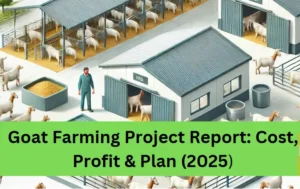
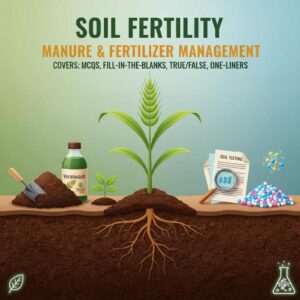
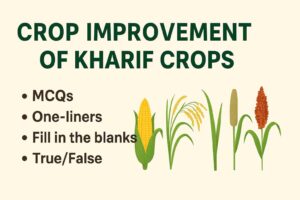


Your site offered uus with helpful info to work on.
Thanks for the marvelous posting! I truly enjoyed reading
it, you’re a great author. I will remember to bookmark your blog and may come back later on. I want to encourage you to definitely continue your great writing, have a nice
afternoon!
Good day I am so thrilled I found your site, I really found you by accident,
while I was searching on Digg for something else,
Regardless I am here now and would just like to say cheers for a remarkable post and a all round enjoyable blog (I also love the theme/design),
I don’t have time to read it all at the minute but I have
book-marked it and also added in your RSS feeds,
so when I have time I will be back to read more, Please do keep up
the excellent jo.
Thank you for the good writeup. It in fact was a amusement account it.
Look advanced to more added agreeable from
you! By the way, how can we communicate?
with email